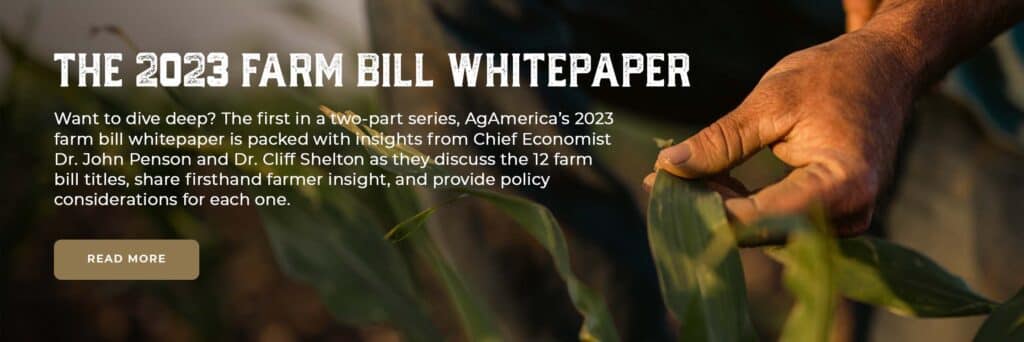Farm Bill 2023: Legislative Updates for Farmers
What is the farm bill?
The farm bill is a collection of legislation that governs agriculture and food policy in the United States. The first farm bill was passed in 1933 and included only 24 pages. In 2018, the farm bill was 529 pages long.
The farm bill has grown increasingly complicated and harder to pass as time goes on. It has a history of being caught in a legislative cycle of extensions, presidential vetoes, and partisan debates.
In this article, we’ll break down the most important parts of the 2023 farm bill and summarize what farmers should expect.

Farm Bill 2023: Timeline and Potential Bottlenecks
Congress will likely put forward a first draft of the 2023 farm bill when they are back from recess in September. This means the bill will almost certainly not be passed before the 2018 farm bill expires on September 30. The 2018 farm bill was the first time since 1965 that floor action in Congress was completed before June.
“My personal sense is that we will do a temporary extension and begin work on passing a new farm bill at the beginning of next year,” said Rep. Kat Cammack, predicting a “political dogfight” as representatives battle it out on the House floor. Other representatives, like Senate Minority Leader Mitch McConnell, believe the farm bill could be passed as soon as December 31 of this year.
Farm Bill 2023: Key Issues Impacting Farmers
As the political debate unfolds, there are several key areas that industry leaders in the U.S. ag sector are keeping a close watch on.
Commodity Income Support and Reference Prices
Programs like Agriculture Risk Coverage (ARC), Price Loss Coverage (PLC), Dairy Margin Coverage (DMC), and others are essential in risk management for farmers because they provide financial protection against price fluctuations. Rising input costs are one of the most significant arguments for increasing statutory reference prices for these programs but, due to budget constraints, lawmakers aren’t entirely sold.
According to Senator Debbie Stabenow, Chairwoman of the U.S. Senate Committee on Agriculture, the committee is debating if 2022 was an anomaly when it comes to price spikes in inputs like fertilizer and fuel and stated that a lack of consensus across regions makes it challenging to know the best course of action.
While major farm groups, like the National Corn Growers Association and the USA Rice Federation, have expressed their support to increase reference prices, other industry groups have voiced their opposition, saying these programs do not cover diversified operations that also need support in times of volatility.
Crop Insurance Accessibility
According to surveys by the National Corn Growers Association, crop insurance is among the most important titles for farmers in the 2023 farm bill.
But similar to reference prices, accessibility is a concern among farm groups. The American Farm Bureau Federation has an expansion of insured commodities among their top priorities for the 2023 farm bill, and strongly opposes any changes that would place the burden of required production practices on farmers.
Budget
SNAP
For the first time, the farm bill is projected to cost more than $1 trillion, roughly $140 billion each fiscal year. Beginning at $867 billion, higher estimates now predict $1.4 trillion, with the Supplemental Nutrition Assistance Program (SNAP) accounting for 80 percent of the budget. SNAP took up 76 percent of the projected outlays during the 2018 farm bill. Because it’s such a large part of the budget, it’s the most hot-topic item for debate on the House and Senate floors.
Partisanship
The record-breaking price tag comes with many hesitations on both sides of the aisle. Already, up to 40 House members have announced that they plan not to support the farm bill. House Democrats are preparing to draw lines in the sand on key issues, while some Republican Representatives have major hangups about SNAP funding.
Conservation Access and Funding
Perhaps one of the most divisive parts of the farm bill, the $20 billion allocated to climate-smart agriculture is predicted to be the source of significant debate. Many groups are interested in improving and increasing access to conservation programs. Between 2010 and 2020, just 30 percent of farmers who applied for EQIP and 42 percent of farmers who applied for CSP nationwide were awarded contracts. Rejecting more than half of farmers who apply not only denies access to those farmers, but also discourages others from attempting to apply at all, especially because the application itself takes a lot of time and effort.
Often, farmers are turned away due to funding issues, which shows how high in demand these programs are. There is a backlog of applications for many programs due to a mixture of USDA understaffing, sheer volume of applications, and other bureaucratic inefficiencies. Some representatives are hoping to increase funding and paint with a wider brush, giving more farmers more access to existing conservation programs.
Industry Group Priorities for the 2023 Farm Bill
Town hall hearings have come to a close, and many farm groups must now wait to see how the debate unfurls in Congress. Based on their talks with representatives, the American Farm Bureau Federation has outlined several priorities for the 2023 farm bill. These include:
- Increasing the farm bill budget
- Overcoming partisan hurdles by uniting nutrition and farming programs
- Ensuring changes to agriculture policy and made via amendments of the Agricultural Adjustment Act of 1938 or the Agricultural Act of 1949
- Increasing funding and access to risk management tools for federal crop insurance and commodity programs
- Improving USDA staffing and technical assistance for farmers
Stay Informed on the Latest Farm Bill News
The farm bill affects many farmers and operators across the country. That’s why it’s essential they are part of the discussion and legislative process. At AgAmerica, we work hard to assist farmers because many of us have farming in our blood. We understand that farming isn’t an easy job, but it’s a vital one.
It’s this commitment to the future of the American farmer that has us keeping a close eye on any policy updates so that we can help you prepare for changes and take advantage of opportunities.
Stay in the loop of the latest legislative developments by signing up for our newsletter and be on the lookout for part two of our 2023 farm bill whitepaper series to learn more about the progress, policies, and bottlenecks of the new farm bill once it’s passed.






